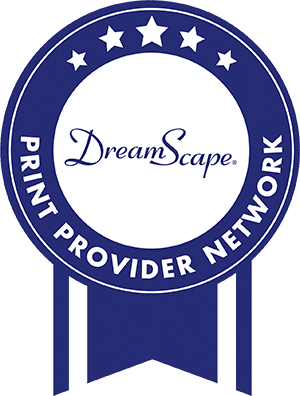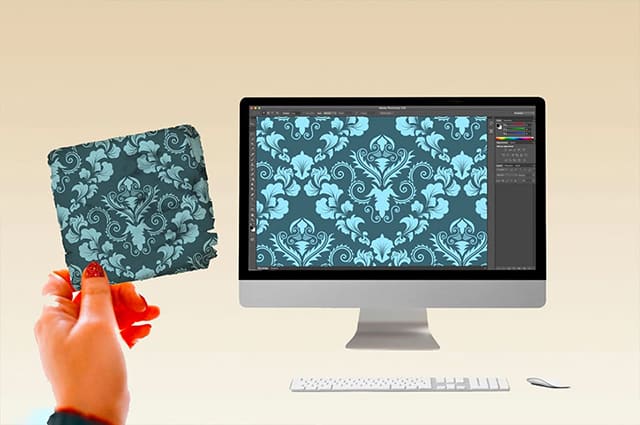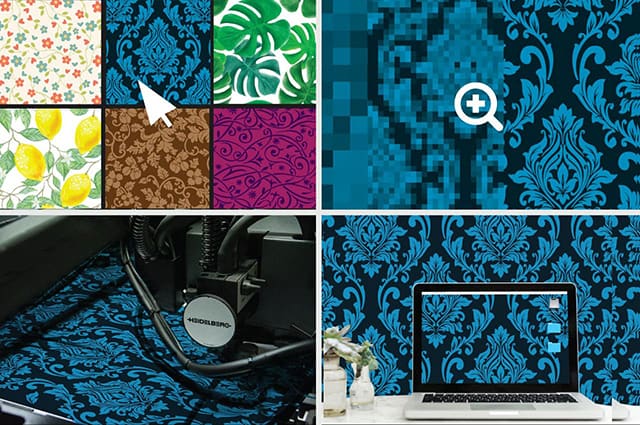NOTE: Please be sure to check your email's Spam or Junk folder since our responses may land there the first time you hear from one of our project managers.
Print Your Own Bespoke Wallpaper
Photowalls • Murals • Temporary Installations • Wall Decals • Print on Ceilings & Floors
Find Out More We print your custom wallpaper designs in high definition, offering a diverse range of textures, finishes & specialties. Our wallpapers are aesthetically pleasing, durable, easy to clean, and simple to install or uninstall. Prioritizing environmental responsibility, our products are fire-safe and VOC-free emissions, ensuring building safety in every design.
We print your custom wallpaper designs in high definition, offering a diverse range of textures, finishes & specialties. Our wallpapers are aesthetically pleasing, durable, easy to clean, and simple to install or uninstall. Prioritizing environmental responsibility, our products are fire-safe and VOC-free emissions, ensuring building safety in every design.Expert Reproduction of Rare & Discontinued Wall Papers
We specialize in converting discontinued, historic & damaged wallpapers into pristine digital files, compatible with any printshop or printing process. Even the most intricate designs are preserved with the highest fidelity, ready for reproduction and use in a variety of contemporary settings.
Send Sample or Photo
We Scan, Process & Retouch
Final Art is Emailed to You
Recreate Your Favorite Wallpaper:
A Custom Revival of Cherished Designs
Scan Samples • Rebuild From a Photo • Historic Restorations • Home Remodels & Renovations
Learn How To Recreate WallpaperHigh Resolution Printing 1200dpi
Specializing in Printing Patterns with Crisp Lines, Vibrant Artwork, and Rich Colors to Produce Striking Graphics or Photos. Experience Astonishing Clarity in Every Print.
Vivid, Fade Resistant Colors
Our wrapping papers are printed with full-color, UV-cured inks, ensuring long-lasting vibrancy without cracking, smudging, or fading over time. Experience the enduring beauty in every print.
Create any Custom Size
Print wallpaper for spaces of every shape and format. Print in any standard size up to 54" x 210", tailored to the specific needs of your project.
Durable & Easy to Maintain
Our materials are not only easy to install and clean, they also resist warping, tearing and fading for wallpapers that will last for years to come.
Browse Our Design Collection
Excellence in Printing
Commitment to Superior Quality and Outstanding Customer Service with Real, Personalized Interactions
Request a Custom Printing Estimate
Companies That Trust Us With Their Vision
Expert Large Format Digital Scanning for Wallpapers & Patterns
Specializing in High-Resolution Scans of Wallpaper Rolls & Intricate Patterns
We do not scan artwork, canvases, prints, photographs or documents.
Extreme Resolution
We offer High-Resolution Scans up to 1200 DPI for Ultra-Crisp Graphics. Our Advanced Technology Enables Magnification of Prints up to 600% of Original Size, Ensuring Unparalleled Detail and Quality for Even the Most Detailed Prints.
Smart Lighting
Each Scan is Custom-configured With Tailored Illumination to Optimally Capture Nuances & Details in a Range of Materials, including Inks, Paints, Photos, And Prints to Achieve The Highest Fidelity In Reproducing Original Works of Art.
Real Stories, Real People
"Wallpaper Time Capsule"
"Uncovered a slice of wallpaper history while renovating. I had a partial sample and some photos. Fine Print not only recreated it perfectly but even managed to capture the original texture. The attention to detail and dedication Fine Print brought to this project is nothing short of remarkable. Now, my home tells an authentic story from the moment you walk through the door, and I couldn't be happier with the results!"
James W. from Miami, Florida
"Dream Wallpaper Come to Life!"
"My 120-year-old house desperately needed a fresh look in the bathroom. I stumbled upon an image of a nearly perfect wallpaper online, but it was nowhere to be found. All I had was a photo; no maker, no name, nothing. I contacted Fine Print, and to my amazement, they made my dream a reality! They recreated the pattern perfectly, and now my bathroom looks like something out of a history book. Amazing!"
Sarah M. from Austin, Texas
"Wallpaper Memories Restored"
"Remodeling our room was a big task, especially because I wanted to preserve the original wallpaper's charm. We had a limited supply of this vintage wallpaper and our renovation had damaged some sections. Fine Print not only understood our situation but brought our treasured wallpaper back to life. Even with partial samples, they worked wonders and made it look better than it ever did. Truly impressive work."
Victor L. from Denver, Colorado
"Wallpaper Remastered to Perfection"
"Our family home, built in 1939, was filled with history and charm. We came across a stunning vintage wallpaper hidden behind layers of paint and other wallpapers. We wanted to recreate it to its former glory as we continued our restoration. Fine Print was our savior. With their expertise, they skillfully reproduced the pattern, taking the damaged pieces into account, and now our home feels like stepping back in time."
Lisa H. from Seattle, Washington
"Wallpaper Time Machine"
"An attic cleanup revealed a roll of antique wallpaper with no branding or hints about the manufacturer. Fine Print helped us to indentify the print and were very helpful in choosing materials and a suitable roll format for our unusually high 12 foot ceilings. They made everything so simple! From just a small sample, they brought it back to life, and now it adorns our home like it did a century ago, as if time had never passed."
Lauren M. from Davenport, Iowa
"Vintage Wallpaper Resurrected"
"My mid-century modern house was a challenge to remodel, but restoring the original wallpaper in my dining room was a particularly daunting task no printshop wanted to touch. Spoke to Fine Print and those guys did not even flinch. Within a couple of weeks they expertly recreated the pattern from my deteriorated samples and printed up brand new rolls. Now, when I step into that room, it's like I'm back in the 1950s."
Daniel S. from Wichita, Kansas
Featured Wallpaper Projects
Our Most Visited Wallpaper Articles
Recent Articles
What Is Large Format Printing?
Specializing in wide format and grand printing, our services extend beyond traditional digital printing to accommodate large-scale projects. Our advanced printing technology encompasses both flatbed and roll-to-roll printers, sometimes combining both. We use UV inkjet, toner-based, or UV gel inks for high-quality, large-scale graphics on rolls instead of individual sheets.
The presses can be either flatbed or roll-to-roll printers and sometimes are a combination of both.
All printing is done with a uv inkjet, toner-based ink or a uv gel ink that prints graphics onto a roll, rather than individual sheets.
Our wide-ranging printing capabilities include:
- Foam, Gator & Sintra Boards for diverse applicationsCustomized solutions for Kiosks, Popup Locations, and Art Prints
- Eye-catching Window Displays and Clings, Available in Clear, Perforated, and Double-Sided options
- Durable Floor, Wall, and Ceiling Decals, Resistant to Scratches & Fading
- Versatile Signs and Banners,Including Double-Sided, Transparent, and Backlit options
- Precision-Cut Vinyl LetteringQuick and Easy application
- Pop Up Shops & TradeshowsWe Offer Weatherproof and Easy-to-Install options
Frequently Asked Questions
General FAQs
Is this the official home page of Fine Print NYC?
This is the homepage for Fine Print New York - an independent print shop with a focus on large format printing. We are pioneers in the recreation and printing of custom wallpapers, merging expert reproduction, historic restorations, and duplication of vintage, discontinued, or out-of-print designs. Our expertise seamlessly bridges the gap between past and present, bringing to life retro designs from the 70s and 80s, as well as Victorian patterns that echo the elegance of a bygone era.
Our commitment to preserving these unique designs ensures that the charm and style of previous generations, like the wallpapers that adorned your grandmother's house, are kept alive and accessible for today's enthusiasts.
We also print original, custom and personalized wallpapers for home/business owners and artists seeking high quality printable wallcoverings and best-in-class service for orchestrating and producing wallpaper of all types, styles and spaces.
How long has Fine Print NYC been in business?
Established in 2004 by creative visionaries with a decade of marketing expertise, Fine Print initially focused on in-house printing needs, swiftly evolving into a comprehensive service.
The turning point came on May 18, when Nike became our first client, marking the first of an extensive roster that now spans from small enterprises to global Fortune 500 corporations who have enlisted our services. Our journey reflects a commitment to quality and versatility in printing, catering to diverse client needs worldwide.
Can I visit your physical location to see samples or discuss a project?
In response to post-pandemic policy changes, our Manhattan office has transitioned to remote client interactions, offering support via phone, chat, or email, while discontinuing in-person meetings. Clients interested in material samples can request them through mail for a nominal fee, ensuring a seamless and accessible experience in exploring our offerings.
Do you offer rush printing services?
Yes, although the concept of a rush applies differently depending on the product. Poster boards, banners and canvas prints can be produced within 24-48 hours. Anything wallpaper related usually requires more lead time, unless the client is exceptionally prepared, has print ready files and is not overly concerned with color matching.
What payment methods do you accept?
You can pay via ACH, check, or with any Credit/Debit Card, which will cost an additional 4% to cover merchant fees.
Do you offer shipping or delivery services?
We ship and deliver anywhere in the continental US. For more expedited deliveries to anywhere in NYC's 5 boroughs, we provide courier service. All shipments are covered by insurance and will require a signature upon delivery. We work with trusted couriers only, so even if your project is private or has sensitive information, you can rest assured that your confidentiality will be honored.
What file formats do you accept for printing?
PDF is the most common format. We also accept all Photoshop formats (PSD, PSB, TIFF) and vector formats (AI, EPS). For digital images we recommend a minimum of 300dpi in order to print details clearly. You should also save your artwork in print-ready CMYK format as it provides a more accurate view of color limitations compared to standard RGB mode, which is meant more for monitors and displays than printers.
Wallpaper Reproduction FAQs
What's the first step in recreating wallpaper designs, how do I get started?
Before we can offer a quote we will need to see the actual wallpaper. It doesn't have to be a high quality photo - a simple snapshot from your mobile phone is enough for us to get an idea of the scope, size and complexity of your unique project.
What's the typical turnaround time for a wallpaper reproduction project?
Recreating wallpaper is a fairly involved process which includes scanning, digital restoration and creativity from a skilled technician, not to mention color matching, printing samples. Projects always vary by complexity and the level of preparedness that each client brings to the table, so turnaround ranges as follows:
Basic Restoration (Few colors, simple design): 2-4 weeks
Moderate Restoration (4-6 colors, detailed artwork): Average 5-7 weeks
Historic Restoration (Match an existing installation): At least 8 weeks for accuracy and color matching
What is the pricing stru cture for wallpaper reproductions? Is it based on size, complexity, or other factors?
For pricing we always look at:
1. The condition/quality of the original sampleA piece which is damaged, dirty or incomplete will require more design hours than a pristine copy.
2. The number of colors and importance of accurate matching Since each color must be separated, each additional color adds to production time. If color matching is critical, this will also increase the cost as multiple rounds of samples must be printed.
3. Complexity of the designThe size and intricacy of the wallpaper will determine just how difficult it will be for our artists to isolate all the shapes and colors.
The best way for us to evaluate your project is to have a visual sample of what you're trying to replicate, even if it's a quick snapshot from your mobile phone we'll be able to let you know the scope and timeframe of the project.
Do I need an original sample/piece of the wallpaper in order to replicate the pattern/design?
While we do recommend scanning original samples, wallpapers can also be recreated from a photograph.
You can learn more about this process in our article How to Reproduce Existing Wallpaper Designs
What's the difference between wallpaper restoration and reproduction?
Wallpaper reproduction is when your original samples are in mint condition and very little digital editing is needed to make it into a produciton-quality file.
By contrast, wallpaper restoration refers to cases where the original sample is damaged or dirty, requiring far more hours of photo retouching to remove blemishes.
How closely can you match my wallpaper? Will I be able to tell the difference?
It depends on the style of wallpaper you are trying to replicate. There are a number of different methods, including digital printing, block printing, screen printing and gravure printing. The more traditional methods can leave a slightly raised texture from the ink, in digital printing, this will replicated with a pre-fabricated paper/substrate with a raised surface. When the digital ink lays down, it can create a similar effect to traditional and more expensive methods of printing.
It's also important to note that, sometimes, due to the age, exposure to environment, condition of the existing wallpaper, or the original manufacturing process, it might can be difficult to match colors exactly. In these cases, we will match the colors as closely as possible to give an overall similar look.
The exception to this is metallic wallpapers. While we can print on metallic materials (gold, silver, copper), our digital presses do not actually print metallic inks/foils.
Regardless of the project specs, it's our company policy never to print any wallpaper without the you seeing a press proof first (a job ticket must be generated). We only go to press when you 100% confirm your custom press proof/sample.
Can I request custom modifications to the original wallpaper design during reproduction?
Absolutely! We can modify your patterns, change colors and edit the size or placement of your wallpaper design.
How do you handle wallpapers with metallic or textured elements during reproduction?
As a digital print shop we do not use metallic inks. That said, we can isolate all metallic elements and assign them a flat color which can then be passed onto a printshop with the capabilities to print metallic inks.
Can I recreate a wallpaper that is currently in print from another company?
Yes, as long as you provide expressed written permission from the publisher/copyright owner.
Open Monday - Friday: 9:30am-5:30pm
*Closed Saturday & Sunday*
Open Monday - Friday: 7:30AM - 3:30PM
*Closed Saturday & Sunday*
Fine Print is a wallpaper store located in NYC offering wall printing services to home owners and design professionals. From panoramic wall murals to even the most bespoke wallpaper designs, our state of the art process ensures photographic results, accurate color matching and outstanding quality.
We can recreate, copy and duplicate existing wallpapers. Regardless of how old, out of print or damaged a sample may be, we offer faithful reproductions and professional guidance to match the look and feel of the original. Bring new life to **vintage wallpaper on a variety of durable and easy to clean materials.
Our wallpaper rolls deliver a maximum printable size of 48” width by 300” height. We offer peel & stick, matte, canvas & fabric, each one fully compliant with industry fire safety & emissions standards. Rest easy knowing that your wallpaper is produced using safe and environmentally friendly materials.

